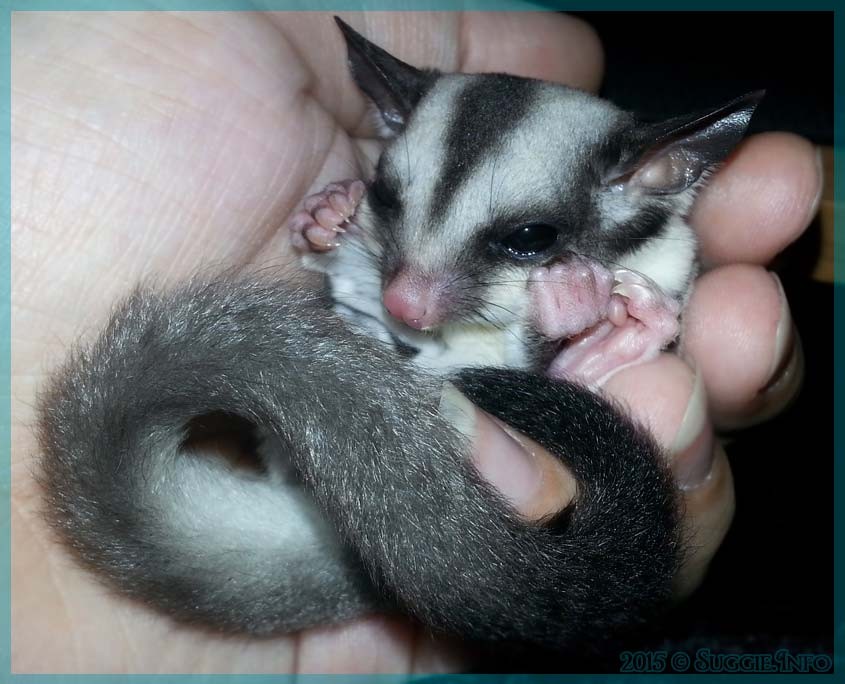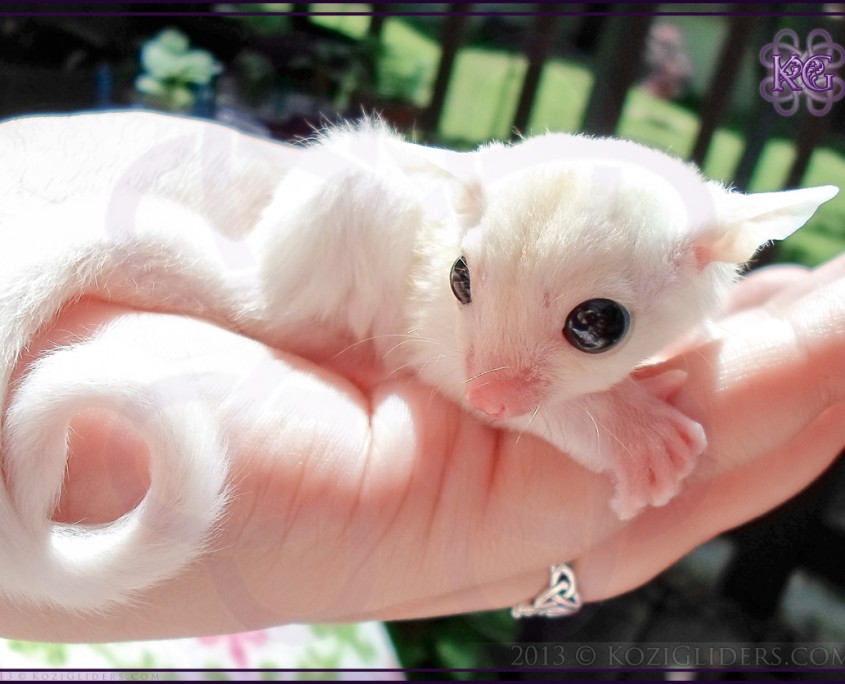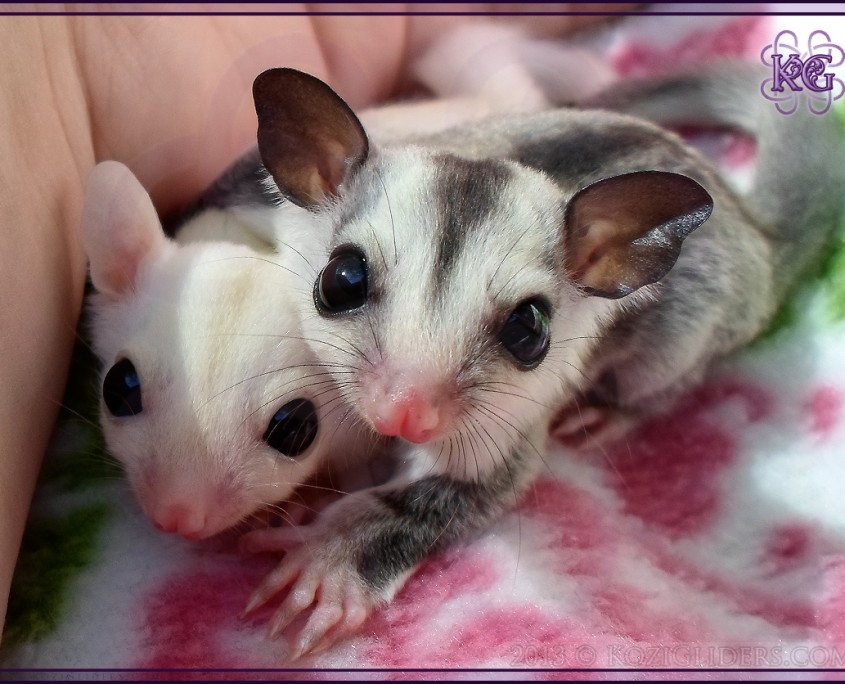Self Mutilation in Sugar Gliders
There are many reasons a sugar glider might self mutilate. These include:
- Pain (of any etiology)
- Stress/ Anxiety/
- Post surgical – issues with stitches or staples
- Following injury inflicted by another sugar glider
- Return of feeling after paralysis/paresis
- Confusion/fear – especially when awakening from anesthesia
- Long standing and untreated parasite or bacterial infection.
- Boredom from neglect by owner
- Abuse by owner
- Nutritional needs not being met
- Grief over loss of cage mate either by death or separation
While self mutilation is seen frequently post neuter, it can occur in any glider of any gender, age or color. Often, self mutilation begins with over-grooming. The owner might notice that the glider has removed the hair on a portion of the chest, belly or tail. There is a characteristic sound that a glider who is going to self mutilate makes. It is specific to self mutilation and is called the SM sound. This sound is difficult to describe, but some have described it as a cross between a crab, a hiss and a desperate cry of pain. Owners should be educated to get a glider in an e-collar immediately if they hear this sound.
Among the most lethal of self mutilation categories is mutilation of the cloacae. One of the most troublesome to treat is mutilation of the tail. In cases where amputation of a portion of the tail is necessary, amputation should occur a few joints above the injured area.
Self mutilation is not the death sentence that it once was. With proper treatment from the vet and the owner, most gliders can overcome self mutilation and go on to lead happy, healthy lives.
The Vet Visit:
Once a glider who is self mutilating is brought in to see the vet, the veterinarian should perform a series of tests as well as a physical examination. Any irritated or over groomed site should be very thoroughly examined. A FF/FS should be conducted. C&S and urinalysis are also indicated. The aim of the veterinarian’s visit should be to determine a cause so that treatment is not of only the SYMPTOM, but is of the underlying event. IF all of the aforementioned tests come back clear, x-rays should be taken to search for broken bones, tumor or other abnormality. Sugar gliders are infamous for trying to chew out their own maladies. In most cases, the glider will have to be anesthetized to clean and repair the damaged area. It is imperative that the veterinarian fit the glider in an e-collar prior to the glider awakening. This will minimize any risk of further damage.
Once the cause of the SM has been ascertained, the vet should then prescribe medications and educate the owner.
MEDICATIONS:
Without question, ANY glider that is self mutilating should be prescribed a MINIMUM of 4 days of pain medication. 7-10 days is recommended. This will not only help ensure that the SM behavior does not recur, but will also assist the glider with tolerating the irritation of the e-collar. Furthermore, it will go a long way toward convincing the owner that you, the veterinarian, have the glider’s needs at heart. While metacam is excellent for decreasing swelling, it should be used with caution in sugar gliders due to links to liver damage with prolonged use. Butorphanol is the preferred pain medication.
Flagyl should be prescribed if parasites are even suspected. Remember, the aim with self mutilation is to decrease the risk of recurrence and to minimize damage. Antibiotics should be prescribed for a minimum of 21 days if infection is suspected or confirmed. A prophylactic prescription of antibiotics is recommended when the damage is significant enough that infection is likely. Follow-Up visits should be scheduled once the round of medications has come to a close to repeat tests.
EDUCATION:
The veterinarian should educate glider owners following the SM exam. Five points should be made very strongly:
1) Diet is extremely important in the healing process for sugar gliders. A glider recovering from injury should be fed increased protein. A glider on antibiotics should be fed yogurt 3-4 X weekly. It is strongly recommended that a glider be fed a diet that has shown great success with facilitating recovery in gliders. BML, HPW and Priscilla Price’s Pet Glider Diet are but a few of these widely known diets.
2) The e-collar is NOT AN OPTION, it is a MUST. Glider owners will often tell of gliders “popping out” of the e-collar or of the glider fighting the e-collar for days. They must be educated that a self mutilating glider will very quickly create even more damage if the e-collar is not kept on. The e-collar must be worn throughout the duration of treatment and until the wound has healed COMPLETELY. Gliders have successfully lived in a n e-collar for years at a time, so there should be no worry about duration of treatment at this time.
There are two different types of e-collars. Recently, great success has been shown from the use of an 8 inch bird collar with snaps that is cut down to just above the innermost row of snaps for the glider. This creates a satellite-type e-collar. The other type of e-collar is called a shot-glass style because it resembles a shot glass in it’s narrow shape. For tail injury, the e-collar is the only thing to keep the glider from reaching the tail.
3) The owner should be counseled to seek the advice of others who have successfully seen one or more gliders through self mutilation. There is a very active, very knowledgeable, very experienced and very supportive online community of glider owners. Networks of glider owners have committed to responding to SM emergencies very quickly. The experienced online community can offer advice for aftercare, medication delivery, where to purchase additional collars, diet and modifications to make to the cage to make it both safe and accessible to the glider in the e-collar.
The online community is populated by a handful of people who have had multiple experiences with self mutilation and have become very well versed in SM aftercare, etiology and theory. These people have made themselves available by phone to any vet or owner who wishes to consult with them. They are:
Val Betts 806-274-9177
Mary H. 979-478-7546
Bourbon 321-331-1608
Every vet and owner who ever comes in contact with a self mutilating glider should keep these numbers on hand.
Furthermore, there are many websites that are either partially or wholly devoted to the care and prevention of self mutilation in sugar gliders. These site addresses should be given to the owner during education along with a strong recommendation that they visit each site, register, and make contact with someone with experience.
These sites are:
glidercentral.net
thesweetspot.forumotion.net
4) The care and treatment of a glider who is self mutilating is very time intensive. The owner must be willing and able to devote 24 hours / day to the glider for the first few days.
In situations where this is not feasible, the owner should be made aware that there are those in the community who have agreed to open their homes at any time to a glider dealing with self mutilation. Rescue homes in Texas and Florida will take in gliders at any time. These should be strongly recommended over euthanasia. If the owner is unsure, encourage them to relinquish the glider to the vet’s care and then the vet can contact any of these homes through the sites noted above.
5) During recovery, the self mutilating glider should be separated from cage mates – In a separate cage 24 hours per day.
After Care
Once an owner has been educated, the vet should expect a few things from the owner. An owner who is dedicated enough to put the time and effort into saving their glider will research and register at the above sites. They might return to the vet with questions and suggestions, as well as information from these sites. The veterinarian should be open minded and willing to research and try new methods. As stated before, the people giving this advice online have most likely been through this several times.
The owners primary jobs after leaving the vet are prevention and treatment. Preventing further damage and recurrence are essential. The owner should keep the glider in the e-collar and should start or continue the glider on a diet that is rich in vitamins, calcium and minerals while maintaining a 2:1 Calcium:Phosphorus ratio. The owner should possess a gram scale and keep track of the glider’s weight loss or gain by weighing them every other day. The veterinarian can expect that medications will be delivered as prescribed, the cage will be modified to make it safe and accessible, and the glider will be kept clean and free of infection. Experienced glider owners will also check daily for dehydration and can deliver sub-Q fluids if necessary. Overall, once the glider leaves the vet clinic, it can be expected that it will be doted upon and treated almost constantly for the first week of treatment. Therefore, the vet should expect to hear form the owner at the first sign of change.
Experienced Members for Consult
The online community is populated by a handful of people who have had multiple experiences with self mutilation and have become very well versed in SM aftercare, etiology and theory. These people have made themselves available by phone to any vet or owner who wishes to consult with them. They are:
- Val Betts 806-274-9177
- Mary H. 979-478-7546
- Bourbon 321-331-1608

caption here

caption here
Please visit this forum, it’s absolutely vital to be in touch with the right people and to review the right information in order to help your glider the best we can.
All content on this page is credit to The Sweet Spot Forum and Val Betts. Images are credited individually on the photo.

